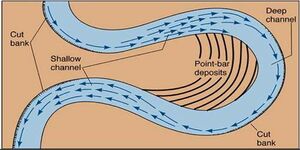Point bar

Побочень (побочень переката)
ПОБОЧЕНЬ, ПОБОЧЕНЬ ПЕРЕКАТА – прирусловая отмель, представляющая собой аккумулятивное скопление наносов, примыкающая к берегу и являющаяся повышенной частью крупной гряды в русле или составной частью переката; на спаде половодья и в межень полностью или частично обсыхает. Как элементы перекатов, побочни образуют морфологическую пару, являясь верхним у одного берега и нижним у другого, разделенные подводной (в межень) частью – седловиной переката. Для смежных перекатов один из побочней является центральным – общим для обоих перекатов, и в рельефе его обсохшей в межень поверхности прослеживается подвалье каждой гряды – посередине побочня верхней, ближе к ухвостью – нижней.
Поверхность П. расширяется вниз по течению и повышается от приверха к ухвостью и от уреза воды к тыловой части, где обычно выражено подвалье гряды. Нередко П. представляет собой сложное образование, составленное двумя-тремя грядами. На перекатных участках П. располагаются в шахматном порядке, на излучинах русла – в зонах замедления течения у выпуклых берегов (по И.В. Попову они называются пляжами), в разветвлениях – у островов ниже их оголовков на заходе в рукава и т.д. На больших и крупнейших реках высота П. над низким меженным уровнем достигает в пригребневой части перед подвальем 5-6 м, ширина – сотен метров, длина – нескольких километров (например, на нижней Лене). При зарастании растительностью П. превращаются в элементы поймы.[2]
Point bar
Point bars typically have an arcuate shape that reflects the radius of curvature of the bend within which they form. An array of forms may be determined, reflecting bend curvature and bed/bank material texture. Point bars are attached to the inner (convex) bank and are inclined towards the center of the channel, reflecting the asymmetrical channel geometry at the bend apex.
They form when helical flow is generated over the bar surface as the thalweg shifts to the outside of the bend at high flow stage. This flow moves sand or gravel bedload by traction processes towards the convex slopes of bends, building the bar laterally.
An around-the-bend set of sedimentary structures and grain size trends is commonly observed. The coarsest materials are deposited at the bar head where the thalweg is aligned closer to the convex bank. Further around the bend, the thalweg moves towards the concave bank and finer-grained sediments (a bedload and suspended load mix) are deposited.
The most recently accumulated deposits are laid down as bar platform deposits at the bend apex.[3]
Пример использования термина на английском языке
1) The model predicts the internal architecture and geometry of fluvial point-bar elements in three dimensions.[4]
2) Low rates of lateral migration (centimetres to decimetres per year) combined with relatively high rates of vertical accretion (millimetres to centimetres per year) recorded in microtidal channels of the Venice Lagoon (Italy) give rise to point-bar geometries and internal facies arrangements that differ substantially from widely accepted models of point-bar sedimentary architecture.[5]
Перевод использования на русском языке
1) Модель предсказывает изменение формы и размеров побочней в трех измерениях.
2) Низкие скорости боковой деформации в сочетании с относительно высокими скоростями вертикальной деформации, наблюдающиеся в приливно-отливных каналах Венецианской лагуны, приводят к увеличению побочней и изменению их расположения, которые существенно отличаются от общепринятых моделей побочней.
Список литературы
- ↑ QS Study [Электронный ресурс]. – Режим доступа: https://qsstudy.com/point-bars-depositional-landforms/.
- ↑ Чалов Р.С. Толковый терминологический и понятийный словарь-справочник по русловедению. – Москва, 2022. – 95 с.
- ↑ Leys K. Geomorphology and river management: applications of the river styles framework, by Gary J. Brierley and Kirstie A. Fryirs. Blackwell Publishing, Oxford, December 2004. 398pp. Price £39.95. ISBN 1-4051-1516-5 (paperback). // Aquatic Conservation: Marine and Freshwater Ecosystems. – 2006. – Т. 16. – № 1. https://doi.org/10.1002/aqc.727.
- ↑ Ghinassi M., Ielpi A., Aldinucci M., Fustic M. Downstream-migrating fluvial point bars in the rock record // Sedimentary Geology. – 2016. – Vol. 334. – P. 66-96. https://doi.org/10.1016/j.sedgeo.2016.01.005.
- ↑ Cosma* M., Yan N., Colombera L., Mountney N.P., D’Alpaos A., Ghinassi* M. An integrated approach to determine three-dimensional accretion geometries of tidal point bars: Examples from the Venice Lagoon (Italy) // Sedimentology. – 2021. – Vol. 68. – № 1. – P. 449-476. https://doi.org/10.1111/sed.12787.